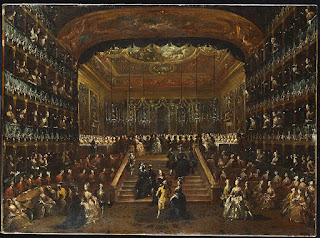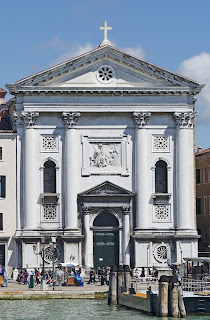Verdi's masterpiece performed for the first time
 |
| The poster advertising the first performance of Verdi's famous opera at Teatro La Fenice in Venice |
The premiere took place at Teatro La Fenice, the opera house in Venice with which Verdi had a long relationship, one that saw him establish his fame as a composer. La traviata would ultimately cement his reputation as a master of opera after the success of Rigoletto and Il trovatore.
La traviata has become the world's favourite opera, inasmuch as no work has been performed more often, yet the reception for the opening performance was mixed, to say the least.
Reportedly there was applause and cheering at the end of the first act but a much changed atmosphere in the theatre in the second act, during which some members of the audience jeered. Their displeasure was said to be aimed in part at the two male principals, the baritone Felice Varesi and the tenor Lodovico Graziani, neither of whom was at his best. There was also criticism of the soprano Fanny Salvini-Donatelli, the first to be given the role of Violetta, the opera's heroine.
Although an acclaimed singer, Salvini-Donatelli was 38 years old and somewhat overweight, whereas Verdi's character was both young and slight and, of course, would ultimately die from consumption. Verdi had tried in vain to persuade the manager at La Fenice to re-cast the role with a younger singer. He had also been overruled over his wish to give the opera a modern setting, in which he had the support of the librettist, Francesco Maria Piave, because the management insisted that the story be set in the past, in around 1700.
Dismayed, Verdi condemned the premiere as a failure, making it clear that he blamed the choice of singers. Impresarios from other cities were eager to put on their own productions but Verdi was reluctant to allow the opera to be staged anywhere if he could not be given assurances over the casting.
In the end, more than a year after its debut, he allowed the opera to be performed again at Teatro San Benedetto, also in Venice, with the much younger Maria Spezia-Aldighieri in the role of Violetta. This time it was a huge success.
La traviata -- generally translated as 'the fallen woman' -- is the story of the ailing courtesan Violetta, who initially resists but then falls for a young admirer, Alfredo, for whom she gives up her party life in Paris to settle in the countryside.
Their blissful relationship is shattered, however, when Violetta is persuaded by Alfredo's father to turn away from his son for the sake of his daughter, whose own engagement is threatened because of the family's links with a courtesan.
 |
| Plácido Domingo, who has sung both tenor and baritone roles in La traviata Photo: Rmm413 (CC BY-SA 4.0) |
They are reconciled only when Violetta falls gravely ill with tuberculosis, or consumption as it was then called, and Alfredo's father tells him the truth just in time for him to arrive at her bedside and ask for forgiveness moments before she dies in his arms.
Verdi based the story of that of a real Parisian courtesan, Marie Duplessis, who similarly died from consumption but was immortalised by Alexandre Dumas fils, the French writer and dramatist, in his novel, La Dame aux Camélias, based on the relationship he had with Duplessis.
A huge success after it was published just eight months after her death, the novel was turned into a stage drama by Dumas and Verdi is said to have seen it while staying in Paris with his lover, the singer Giuseppina Strepponi.
As well as being performed at opera houses around the world, La traviata has twice been made into a film, notably by Franco Zeffirelli in 1982, when Plácido Domingo starred as Alfredo opposite the Canadian soprano, Teresa Stratas. Domingo, then only 41, has in more recent years taken the role of Alfredo's father, Giorgio, which is normally assigned to a baritone.
A lavish new production, directed by the American film director Sofia Coppola with the support of the fashion designer, Valentino, is to be staged at the Opera of Rome in May of this year.
 |
| The Teatro San Benedetto, which is nowadays a cinema, was Venice's major opera venue before La Fenice |
The Teatro San Benedetto, which was situated just 200 metres away from La Fenice's location in the San Marco district of Venice, predates La Fenice and itself staged the premieres of more than 140 operas but after a legal battle in the late 18th century forced a change of ownership the theatre declined in importance. Its name changed to Teatro Venier, Teatro Gallo and finally Teatro Rossini, in honour of the opera composer Gioachino Rossini but as La Fenice flourished it never regained its position as Venice's major opera venue. In the 1930s it was remodelled as a cinema and although the original building was demolished in 1951 the theatre was reconstructed on the same site in Salita del Teatro and now forms part of the Multisala Rossini, which is Venice's largest cinema.
 |
| The statue of Verdi in Busseto Photo: Viva-Verdi (CC BY-SA 3.0) |
Giuseppe Verdi was born at Le Roncole, a village in the Parma province of Emilia-Romagna in 1813 and moved in 1824 to the nearby town of Busseto, which stages an annual opera competition, Voci Verdiane (Verdian Voices), and has a number of monuments to the composer, including the Teatro Giuseppe Verdi. The Casa Barezzi, close to Busseto's main square, was the home of Antonio Barezzi, Verdi's first patron. Since 2001 it has housed a permanent exhibition of objects and documents relating to Verdi, including his first portrait and a number of letters. For more information, visit www.museocasabarezzi.it
Busseto hotels from Booking.com
More reading:
Verdi - Italy's mourning for the death of a national symbol
Rigoletto's debut at La Fenice
How rival fans wrecked the premiere of Rossini's Barber of Seville
Also on this day:
1483: The birth of historian Francesco Guicciardini
1933: The birth of Augusto Odone, inventor of 'Lorenzo's oil'
Home
Home













